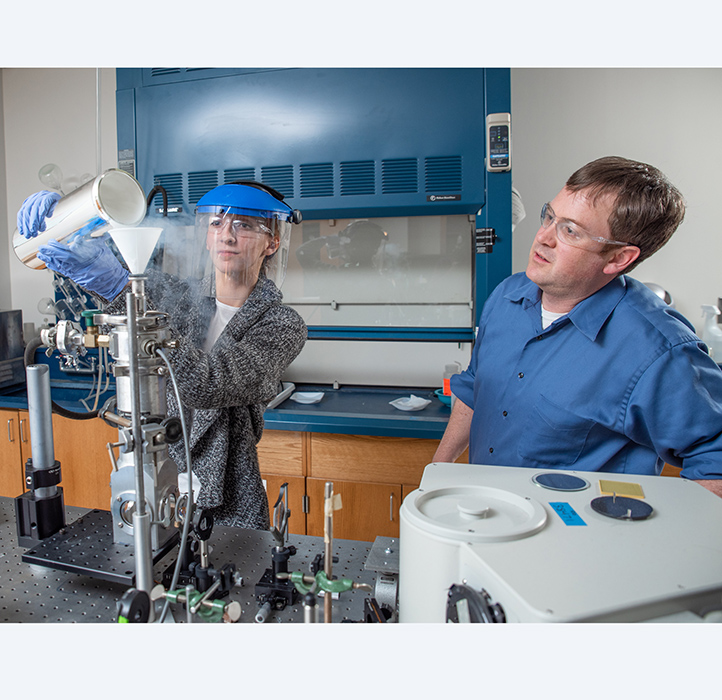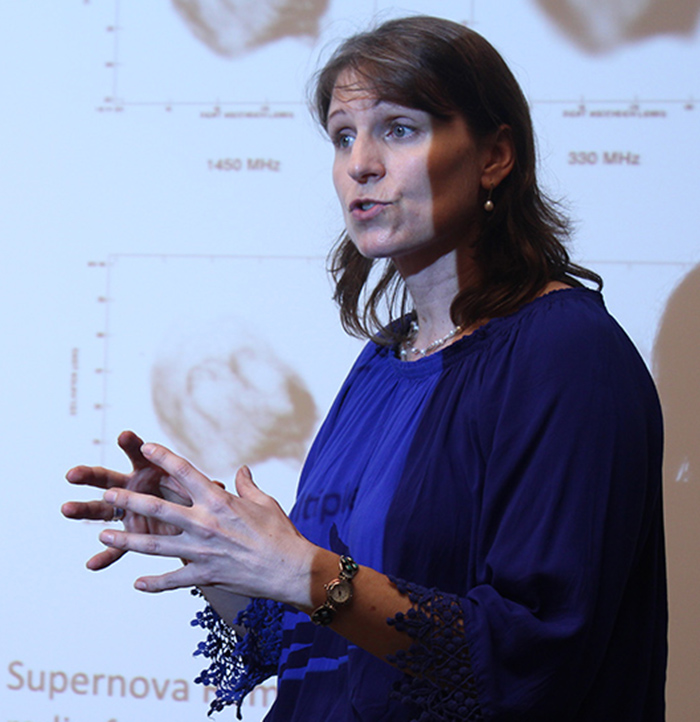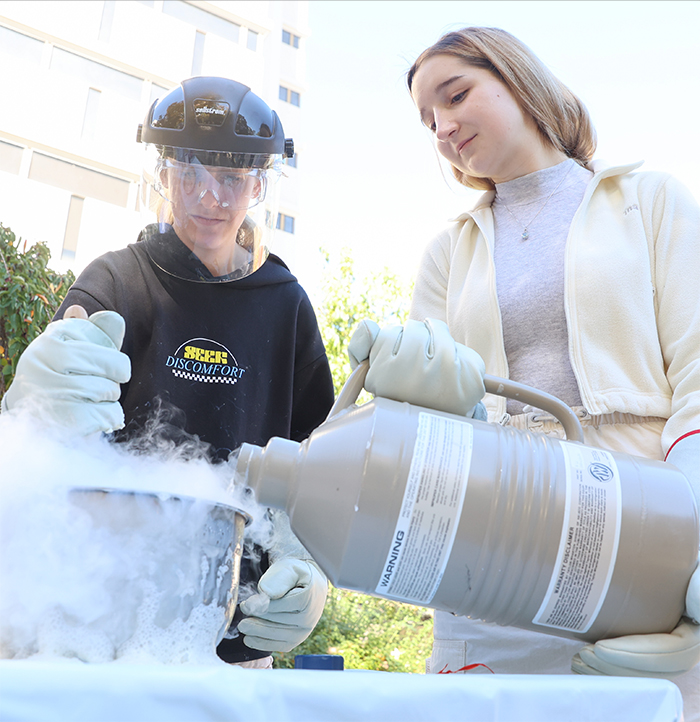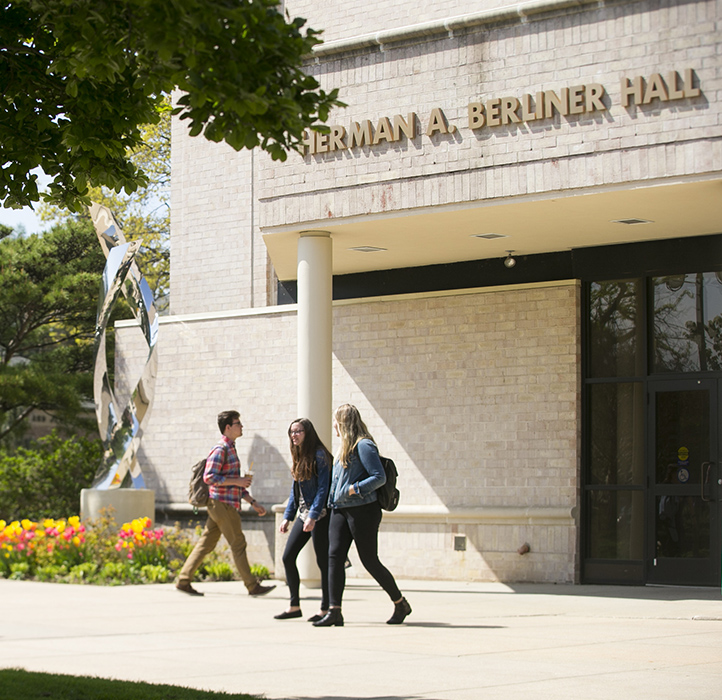Study the laws that govern the universe, from the biggest galaxies in the cosmos to the smallest subatomic particles in the body.
Majors and Programs
You will explore the foundations of physics, the roles of hypotheses, measurement and analysis, and the development of scientific theory through small classes and laboratories. Intermediate level courses in modern physics, mechanics, optics, and electricity and magnetism will further prepare you for senior-level courses in quantum mechanics and statistical mechanics.
Hofstra offers three degree options in the Department of Physics , as well as minors in Astronomy and Physics. The department is also home to a graduate program in medical physics.
Physics may also serve as a hub for other disciplines - double majors with mathematics, chemistry, and engineering are popular.
Explore physics undergraduate courses
BA in Physics
The BA in Physics is best for students who are interested in teaching at the middle or high school level or are interested in technical careers that don't require graduate degrees. This degree gives students the freedom to take courses in the liberal arts and pursue other minors. The BA also makes sense for students who will be pursuing careers in law, business, or medicine.
BS in Physics
The BS in Physics is better suited for students who are planning careers as research scientists or in technology fields that require advanced degrees in physics or engineering.
BS in Applied Physics
The BS in Applied Physics allows students to combine the BS in Physics with a concentration in biochemistry, computer science, or engineering. The curriculum includes electives in humanities and social science to give the student a general background to supplement training as a specialist.
Follow Your Own Path
Students begin by exploring the foundation of physics before moving on to courses in modern physics, mechanics, optics, electricity and magnetism, quantum mechanics, and thermodynamics. Beginning in sophomore or junior years, about half of our majors elect to participate in research programs or advanced projects continuously until graduation.

Learn from the Experts
Faculty research interests include supernova and black holes; quantum information and dissipative quantum systems; high-energy physics and string theory; superconductivity and topologic insulators; laser spectroscopy and solar cells; and massive star formations. Professors have participated in Nobel Prize-winning research and have published in prestigious, peer-reviewed journals. One professor was recently honored as a Fellow of the American Astronomical Society and several are Kavli Institute for Theoretical Physics scholars.

The Student Experience
Internships and fellowships provide real-world experience and help focus an undergraduate's professional goals. Recent internships and fellowships for physics majors have included Brookhaven National Laboratory, Cornell University, Cradle of Aviation Museum, and New York Atlantic Railway.
Students have also been accepted to participate in Research Experiences for Undergraduates (REUs) at Cornell University, the University of Oklahoma, and Texas A&M University. The department is also home to chapters of Sigma Pi Sigma Honor Society and the Society of Physics Students, which help cultivate a tight-knit atmosphere among students and faculty.


Labs and Resources
Studying physics at Hofstra means you’ll have lots of opportunities as early as your first year to engage in long-term research projects with your professors and work in technologically advanced facilities, including our low temperature condensed matter physics laboratory, biophysics laboratory, and rooftop observatory with advanced CCD imaging. These labs investigate such practical applications as high-temperature superconductivity and advanced imaging of cell membranes.
Our research groups in theoretical physics and astrophysics study phenomena ranging from supernova explosions to the exotic states of topological superconductors that may be the platform for future quantum computers.
The Hofstra University Observatory
is the primary campus facility for astronomical education and research. Originally funded by a grant from the National Science Foundation, the observatory is used by students in astronomy courses to make observations of the sun, moon, planets, stars, nebulae, and galaxies for course and lab work and by the general public during our “Stars on Sundays” and other astronomy outreach events.
The observatory, located on the roof of Herman A. Berliner Hall, includes an array of Celestron telescopes and a specialized solar-viewing telescope, including many GPS models with automated “go-to” functionality for thousands of celestial targets. Physics majors and astronomy minors can use the HURCULAES camera – a research-grade 8-megapixel CCD detector and filter wheel – for cutting-edge scientific research.
The Low Temperature Condensed Matter Lab
features a large-bore superconducting magnet capable of fields up to 9 T, with sample stages that reach temperatures of 1.8 K, which can rotate while cold in-field, with a two-stage liquid nitrogen/liquid helium reliquefier attached to the cryostat. Recent projects focus on magnetotransport experiments on exotic superconducting states found in candidate topological superconductors that are rotational symmetry breaking, and on high-temperature superconductors which are simultaneously ferromagnetically ordered.
The Biophysics Research Lab
has several experimental capabilities, including optical spectroscopy, fluorescence microscopy, and atomic force microscopy. Experimental activities include developing new fluorescence and polarization imaging techniques, studying fluorescence proteins under unusual environmental conditions, and quantifying biophysical processes using single-molecule methods.
Additional laboratories:
-
The Laser Laboratory
-
Teaching Laboratories and the Advanced Physics Laboratory
-
The Computational Research Lab
-
The Computer Laboratory, supported in part by a grant from the National Science Foundation
Outcomes
100%
of recent alumni from our programs in the natural sciences and mathematics reported they were employed and/or attending or planning to attend graduate school within a year of graduation.
100%
of those students reporting employment responded that they landed their position before or at the time of their graduation
$48K
is the mean annual salary of recent alumni, following their first year after graduation

